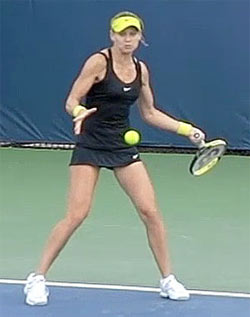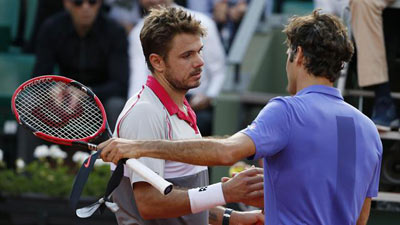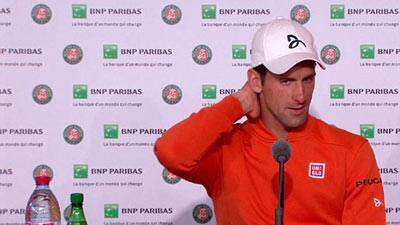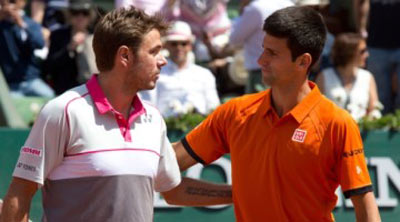|
TennisOne Lessons 10 Lessons You Can Learn from the French Open Paul Fein Serena Williams made it halfway to a rare Grand Slam at the French Open, while Novak Djokovic’s quest for it failed. Two late-bloomers emerged as surprise finalists: Stan Wawrinka who foiled Djokovic’s bid, and Lucie Safarova who nearly derailed Serena’s. Here are several lessons tournament and recreational players can learn from these finalists, and about why they won or lost.
Never Give Up “I left at a set and 4-1 to interview Serena, and then all hell broke loose,” remarked NBC analyst Mary Carillo, who assumed Serena would steamroll slender Safarova in the second set of the French Open final. Serena, in fact, led 6-3, 4-1, 40-15—just five points away from the championship. But super server Serena inexplicably double-faulted on break points to donate the game and her next service game to Safarova to tie the set at 4-all. “Credit Safarova for continuing to compete,” said NBC analyst John McEnroe. “Just shows you, you never know.” How right McEnroe is! No matter what the score or how much of an underdog you are, never, never give up. Safarova kept fighting and attacking and turned the match completely around. She won a decisive 7-2 tiebreaker and then led 2-0 in the deciding set. But we’ve seen this Serena movie before—many times. The most ferocious fighter since 1990s superstars Steffi Graf and Monica Seles, Serena had already pulled out four Roland Garros matches after dropping the first set, despite suffering from the flu. Saving her most dramatic Houdini-like escape for the final, she reeled off the last six games for a 6-3, 6-7, 6-2 triumph and her 20th Grand Slam title. “I’ve never seen a player come back from being so close to defeat and turn it around as often as Serena has,” marveled McEnroe. “It’s amazing.” Forget Your Past Records Against Opponents Wawrinka was 3-16 vs. Federer and 3-17 vs. Djokovic going into Roland Garros. Those lopsided records were irrelevant because nearly all of late-blooming Wawrinka’s losses came before 2013 when he emerged as a legitimate contender for major titles. On the plus side, he defeated Federer in the 2014 Monte Carlo Masters final on clay, his favorite surface and Federer’s worst. Wawrinka also trended positively against Djokovic as their previous four matches at Grand Slam events went five sets, highlighted by his marathon victory at the 2014 Australian Open where he won his first major crown.
So, accentuate the positives in your rivalry and exude confidence, as Wawrinka did after he defeated Jo-Wilfried Tsonga in the semifinals. “My game, when I play my best, I know I can beat any player,” said Wawrinka. Safarova had lost all eight matches to Serena, but she also entered the final with optimism because three of those matches had gone three sets, including their most recent encounter in Beijing last October. Review what worked and what didn't in your past matches with a given opponent, but don't worry about your won-lost record. If you have a big edge in a personal rivalry, you could take her lightly and be overconfident. If you rarely or never beat a particular player, you could be unconfident, even fatalistic. Instead of those dangerous scenarios, treat each match as a new and exciting challenge. Channel Your “Inner Beast” “Lucie was always one of those players you’d scratch your head about,” said former No. 1 and Tennis Channel analyst Lindsay Davenport. “She’s so good, but why isn’t she doing better?” The 28-year-old Czech boasted a complete game, trained diligently, and competed hard, but couldn’t crack the top 10. Was Safarova, one of the best-liked players on the tour, simply too nice? Rob Steckley, her coach for the past three years, thought so. “You’ve got to be extremely hungry and can’t be a nice girl,” Steckley told The New York Times. “You’ve got to dig deep and get yourself dirty and not be afraid to go for the win. That’s what Serena does best. … There’s a reason why she has 20 Slams under her belt. It’s something in her, something in the blood. I think Lucie has it. She just doesn’t realize how much she has it, but then maybe it’s an intimidating thing. Lucie might be afraid of that inner beast.” Serena yelled, pumped her fist, and cursed during her third-set comeback as she intensely willed herself to win. She certainly suffers from no identity crisis. The tennis court is her battlefield. As Steckley added, “She can go off for a while and then she gets the rhythm back, and she locks in. She’s like an F-16. Lock. Target. Die.” If you’re just a little too nice for your own good, like Lucie, don’t be afraid of your “inner beast.” Instead, channel it. Two Hands are Still Better Than One Do those who contend that the two-handed backhand is much superior to the one-hander have some explaining to do after one-hander Wawrinka won his second major title at Roland Garros? Not really. Why? Because the rare exception, such as Wawrinka, merely tests—rather than disproves—the rule (based on empirical evidence) that two hands for the backhand nearly always produce more power, control, and consistency than one hand. Wawrinka, nicknamed "Stanimal," has two great assets: impeccable technique and bull-like strength. His one-hander is much stronger than that of 17-time major titlist Federer, as he repeatedly proved in overpowering his Swiss compatriot 6-4, 6-3, 7-6 in the quarterfinals. No one-handed backhand player comes close to Wawrinka, but the two-handed backhands of Djokovic, Nishikori, Murray and several others have proved better on a consistent basis.
Before the final, Carillo averred, “It’s almost impossible for a one-handed backhand [player] to win a major.” Wawrinka may be the last one to do it, though. The husky 6’, 185-pounder did hit some sensational backhands on big points, especially five down-the-line winners struck in the last three games of the final. Even so, he produced only seven total backhand winners, while committing 20 unforced errors and nine forced errors on his backhand. Wawrinka defeated Djokovic 4-6, 6-4, 6-3, 6-4 in what he described as “the match of my life,” for four main reasons, only one of which was related to his backhand. First, his powerful first serve went in 67% of the time, and he won 76% of those points, while losing serve only twice, despite Djokovic having 10 break point chances. (Wawrinka staved off an even more stunning 16 of 17 break points against Jo-Wilfried Tsonga in the semis.) Second, his relentlessly aggressive forehand pounded 25 winners and defended effectively when he was pushed deep or wide. Third, he won an impressive 70% (23 of 33) of the points at net. Fourth, Wawrinka's bludgeoning groundstrokes forced Djokovic to retreat. After three sets, the lithe Serb was standing more than 6' behind the baseline 46% of the time during rallies, compared to an average of just 26% in his six previous matches. From such a defensive position, Djokovic could seldom be offensive. Smart Shot Selection is Crucial Wawrinka came to the net at the right times and won 23 of 33 points for 70% when he did. Like a boxer going for a knockout in the later rounds, Wawrinka rushed net 24 times in the deciding set. In contrast, Djokovic, when he had Wawrinka in trouble, failed on numerous occasions to seize short-ball opportunities by approaching net. He came into net only 24 times and won only 14 points for a mediocre 58%. Wawrinka also hit enough down-the-line backhands to keep Djokovic off-balance and on the run. Hoping to wear Wawrinka out, as he did when he beat him 6-0 in the fifth set at the 2015 Australian Open, Djokovic too often hit drop shots when he should have tried for winners or strong approach shots. Drop shots worked well against Nadal because the Spaniard was positioned far behind the baseline, but they increasingly backfired against the alert Wawrinka, who was positioned much closer to the baseline.
After his upset loss, Djokovic said, “In some important moments, he came up with the big shots and I didn’t. He just played some really good tactical tennis and also very aggressive shots in some break points, like in 4‑all in the fourth [set], the winner passing shot down the line.” That post-mortem analysis was accurate as far as it went, but all those high-risk drop shots, particularly when he missed several lobs on the next shot, also indicated Djokovic panicked, and that led to poor shot selection. The most foolish decision was to serve and volley on a second serve at 4-all, 40-all in the deciding set. Wawrinka rifled a return at the feet of Djokovic, who erred badly on a backhand volley. That blunder may have cost Djokovic the championship because on the next point Wawrinka broke his serve with a backhand winner. Then Wawrinka held serve in the final game. Secondary Game Plans are Essential to Turning Matches Around After soundly losing the first two sets in his 6-3, 6-3, 5-7, 5-7, 6-1 semifinal loss to Djokovic, Andy Murray made three changes, according to former world No. 4 Gene Mayer. “He lifted the trajectory of his forehand with heavy topspin early in the point, he flattened out the forehands to produce more power when he had the opportunity to attack, and he took the balls early off the backhand to reduce Djokovic’s reaction time,” explained Mayer. Wawrinka also made smart changes to his original game plan after losing the first set in his stunning upset over Djokovic. “In the first set, he apparently did not want to make too many unforced errors, and this blunted his attacking style and gave Novak rhythm,” noted Mayer. “Stan realized that opportunistic attacking was the key to a potential turnaround. This stylistic change unnerved and confused Djokovic, and took him out of his comfort zone by placing the pressure on him.” Always have alternative game plans ready if your initial strategy proves ineffective. Power Prevails, Even on Clay Bigger and stronger athletes, more powerful rackets and spin-enhancing synthetic strings, improved technique, and greater use of topspin to control the increased power have combined to turn pro tennis, for the most part, into baseline slugging. In many matches, both players average 70 to 80 miles per hour for their groundstrokes (even when counting much-slower drop shots and lobs), a statistic unheard of before this century.
Power nearly always trumped consistency in key matches at Roland Garros—even on the slowest surface in tennis. Djokovic whacked 29 more winners than Nadal (45 vs. 16) and 20 more than Murray (56 vs. 36); Wawrinka blasted 30 more winners than Djokovic (60 vs. 30); Serena had18 more winners than Safarova (34 vs. 16); and surprisingly, Safarova hit 14 more than heavy-hitting Sharapova (34 vs. 20). Unforced errors remain an important statistic, but that category should shrink because power tennis inevitably creates more forced errors and winners. The last man to win a major title chiefly with consistency, rather than power, was Gaston Gaudio at the 2004 French Open. Hard-hitting women have captured a staggering 60 of 62 majors since 2000, the only exceptions being Anastasia Myskina and Francesca Schiavone. So, unless you want to be overpowered, turn as many strokes as you can into power strokes. Win Your Tiebreakers Safarova, who uses the mental technique of visualization to keep her focused, won all six tiebreakers she played at Roland Garros, giving up three points or less in four of them. That enabled her to be the only singles player to reach the final without losing a set. “She has the amazing ability to play her best at the big moments,” noted Tennis Channel analyst Lindsay Davenport after Safarova seized crucial tiebreakers against former Wimbledon finalist Sabine Lisicki, No. 2 seed Maria Sharapova, and Garbine Muguruza. Americans Bethanie Mattek-Sands and Mike Bryan grabbed tiebreakers in their last three matches, including a 10-8 super tiebreaker in the semifinals, when they captured the mixed doubles title. Who wins tiebreakers often determines who wins three-set and five-set matches. Tiebreakers are that important. So when you play a practice set or match that doesn’t go to a tiebreaker, be sure to play a tiebreaker or two after that. That will help keep your tiebreaker focus, tactics, and skills sharp. They’ll need to be, because every point in a tiebreaker is precious. Playing Doubles is No Trouble for Women Conventional wisdom says elite singles players court danger when they play doubles because competing in two events is too taxing nowadays. Not so, says Martina Navratilova who competed regularly in both events (and even mixed doubles at majors) and racked up untouchable career records of 167 singles and 177 doubles titles. “Doubles makes you a better singles player and singles makes you a better doubles player,” rightly contends Navratilova. “It’s too much for the men, but also playing doubles is not too much for the women, who play two of three sets. If you’re too tired to play doubles, you’re not in good enough shape to play singles.” Singles finalist Safarova, lean and fit, proved Navratilova right by teaming with American veteran Bethanie Mattek-Sands to win the doubles title, the second leg of what could become a Grand Slam for them this year. Safarova, an adept volleyer and smasher, won a terrific 76% (38 of 50) of her net points in seven singles matches. Doubles clearly has improved Safarova’s singles, and with a No. 7 singles ranking and a No. 5 doubles ranking, she’s the only player—male or female—who ranks in the top 10 in both events. Losing Graciously is Hard to Do, But it Can Be Done Losing is a bitter pill to swallow, especially when you’re the favorite. Jimmy Connors, John McEnroe, and Serena, for most of her storied career, were bad losers. They exuded anger, produced excuses, and only grudgingly, if at all, credited their victorious opponents.
Despite being denied in his 11th attempt for the only Grand Slam title he has yet to win, Djokovic displayed extraordinary grace and warmth toward Wawrinka. His post-match embrace and chat at the net with the winner was a pleasant departure from the usual quick and perfunctory handshake. The often-fickle French fans gave Djokovic, not always their favorite in the past, one of the most prolonged and enthusiastic ovations ever given a runner-up. His praise for the underdog champion at the awards ceremony was sincere and thoughtful. Speaking in French, Djokovic said, "It's not easy for me to speak right now, but I have to say that in life some things are more important than victories and those are character and respect. I have great respect for you, Stan. You are a great champion with a big heart and you deserve this title." Whatever your playing level, ability, and aspirations, you can learn a lot from the pros — from both their successes and their failures, as well as how they handled them. * * * * * Your comments are welcome. Let us know what you think about Paul Fein's article by emailing us here at TennisOne.
Paul Fein Paul Fein has received more than 30 writing awards and authored three books, Tennis Confidential: Today’s Greatest Players, Matches, and Controversies, You Can Quote Me on That: Greatest Tennis Quips, Insights, and Zingers, and Tennis Confidential II: More of Today’s Greatest Players, Matches, and Controversies. Fein is also a USPTA-certified teaching pro and coach with a Pro-1 rating, former director of the Springfield (Mass.) Satellite Tournament, a former top 10-ranked men’s open New England tournament player, and currently a No. 1-ranked Super Senior player in New England. |
||||||||||



